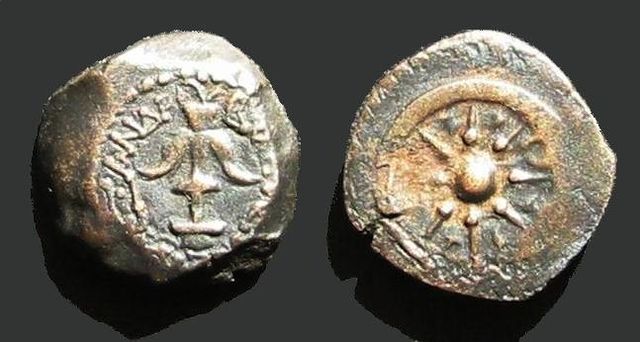Loading AI tools
From Wikipedia, the free encyclopedia
Hasmonean coinage are the coins minted by the Hasmonean kings. Only bronze coins in various denominations have been found; the smallest being a prutah or a half prutah. Two Roman silver denarii are associated with the Hasmoneans; one has the inscription BACCIVS IVDAEAS; with its exact meaning unclear (short for "BASILEOS IUDAEAS", King Judas?)[citation needed]. Both show a man thought to be Yehuda Aristobolus bowing before a camel with a palm branch in his hand.[citation needed]
This article needs additional citations for verification. (December 2023) |

The Hebrew inscriptions found on Hasmonean coins are:
The era of Hasmonean rule lasted for 103 years.[dubious – discuss] It was founded by High Priest Simon son of Matityahu, and consolidated by his son Yochanan surnamed Hyrcanus. Thereafter followed Yehuda Aristobolus, Salome Alexandra, Alexander Yannai and then feuding brothers Hyrcanus II and Aristobulus. Hyrcanus and Aristoblulus each asked the Roman Republic to intervene on their behalf; as a result Judea fell under the greater rule of Rome as an autonomous province but still with a significant amount of autonomy. The last Hasmonean king was Aristobulus's son Matityahu Antigonus.
In 138 BCE, the Seleucid King Antiochus VII Sidetes published a royal decree, granting Simon Maccabaeus the right to mint his own coinage.[2]
John Hyrcanus (in Hebrew Yochanan Hyrcanus; reigned 134–104 BCE, until his death). Minted prutot that said:
He also had monograms on some prutot on the cornucopia side, just left of the cornucopia, some resembling Ά, Π or Λ.
The Jerusalem-minted bronze prutah had on the reverse a double cornucopia adorned with ribbons with a pomegranate between horns, with borders of dots.[3]
Alexander Jannaeus (also known as Alexander Jannai/Yannai), king of Judea from (103 to 76 BCE), son of John Hyrcanus, inherited the throne from his brother Aristobulus, and married his brother's widow, Shlomtzion or "Shelomit".
The Jannaeus coins are the most typical Jewish coins found at archeological sites in the former lands of the Hasmonean kingdom. They represent over 87% of the coins discovered in Jerusalem and 39% of the Hasmonean, Herodian, and Byzantine coins found in the southern Levant. Gamla was the site of the largest-ever discovery of Jannaeus coins from a single location.[4]

Antigonus the Hasmonean (also known as Matityahu Antigonus)[5] was the son of King Aristobulus II of Judea.
Obv: Menorah with Greek inscription "BASILEWS ANTIGONOY" (King Antignus).
Rev: Showbread Table (Shulchan) with Hebrew inscription "Matityahu HaKohen" (Matityahu the High Priest).[6]
Obv: Double cornucopia with ancient Hebrew script; reading "Matityahu Kohen Gadol Chever Hayehudim" (Matityahu the High Priest, Council of the Jews).
Rev: Greek inscription; reading "BASILEWS ANTIGONOY" (King Antignus).
Seamless Wikipedia browsing. On steroids.
Every time you click a link to Wikipedia, Wiktionary or Wikiquote in your browser's search results, it will show the modern Wikiwand interface.
Wikiwand extension is a five stars, simple, with minimum permission required to keep your browsing private, safe and transparent.